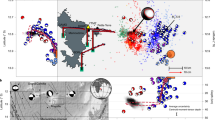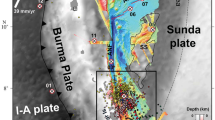Abstract
Volcanoes at spreading centres on land often exhibit seismicity and ground inflation months to years before an eruption, caused by a gradual influx of magma to the source reservoir1,2,3,4. Deflation and seismicity can occur on time scales of hours to days, and result from the injection of magma into adjacent rift zones5,6,7,8. Volcanoes at submarine rift zones, such as Axial Seamount in the northeast Pacific Ocean, have exhibited similar behaviour9,10,11,12, but a direct link between seismicity, seafloor deformation and magma intrusion has never been demonstrated. Here we present recordings from ocean-bottom hydrophones and an established array of bottom-pressure recorders that reveal patterns of both microearthquakes and seafloor deformation at Axial Seamount on the Juan de Fuca Ridge, before it erupted in April 2011. Our observations show that the rate of seismicity increased steadily during a period of several years, leading up to an intrusion and eruption of magma that began on 6 April 2011. We also detected a sudden increase in seismo-acoustic energy about 2.6 h before the eruption began. Our data indicate that access to real-time seismic data, projected to be available in the near future, might facilitate short-term forecasting and provide sufficient lead-time to prepare in situ instrumentation before future intrusion and eruption events.
This is a preview of subscription content, access via your institution
Access options
Subscribe to this journal
Receive 12 print issues and online access
$259.00 per year
only $21.58 per issue
Buy this article
- Purchase on Springer Link
- Instant access to full article PDF
Prices may be subject to local taxes which are calculated during checkout




Similar content being viewed by others
References
Bjornsson, A., Johnsen, G., Sigurdsson, S., Thorbergsson, G. & Tryggvason, E. Rifting of the plate boundary in North Iceland 1975–1978. J. Geophys. Res. 84, 3029–3038 (1979).
Tryggvason, E. Widening of the Krafla fissure swarm during the 1975–1981 volcano-tectonic episode. Bull. Volcanol. 47, 47–69 (1984).
Pedersen, R., Sigmundsson, F. & Einarsson, P. Controlling factors on earthquake swarms associated with magmatic intrusions; Constraints from Iceland. J. Volcanol. Geotherm. Res. 162, 73–80 (2007).
Ebinger, C. et al. Length and timescales of rift faulting and magma intrusion: The afar rifting cycle from 2005 to present. Ann. Rev. Earth Planet. Sci. 38, 439–466 (2010).
Einarsson, P. & Brandsdottir, B. Seismological evidence for lateral magma intrusion during the July 1978 deflation of the Krafla Volcano in NE Iceland. J. Geophys. Res. 47, 160–165 (1980).
Brandsdottir, B. & Einarsson, P. Seismic activity associated with the September 1977 deflation of the Krafla central volcano in northeastern Iceland. J. Volcanol. Geotherm. Res. 6, 197–212 (1979).
Tryggvason, E. Surface deformation at the Krafla Volcano, North Iceland, 1982–1992. Bull. Volcanol. 56, 98–107 (1994).
Belachew, M. et al. Comparison of dike intrusions in an incipient seafloor spreading segment in Afar, Ethiopia: Seismicity perspectives. J. Geophys. Res. 116, B06405 (2011).
Dziak, R. P. & Fox, C. G. Long-term seismicity and ground deformation at Axial Volcano, Juan de Fuca Ridge. Geophys. Res. Lett. 26, 3641–3644 (1999).
Fox, C. G., Chadwick, W. W. & Embley, R. W. Direct observation of a submarine volcanic eruption from a sea-floor instrument caught in a lava flow. Nature 412, 727–729 (2001).
Tolstoy, M. et al. A sea-floor spreading event captured by seismometers. Science 314, 1920–1922 (2006).
Dziak, R. P. & Fox, C. G. The January 1998 earthquake swarm at Axial Volcano, Juan de Fuca Ridge: Hydroacoustic evidence of seafloor volcanic activity. Geophys. Res. Lett. 26, 3429–3432 (1999).
Chadwick, W. W., Nooner, S. L., Zumberge, M. A., Embley, R. W. & Fox, C. G. Vertical deformation monitoring at Axial Seamount since its 1998 eruption using deep-sea pressure sensors. J. Volcanol. Geotherm. Res. 150, 313–327 (2006).
Haxel, J. H., Dziak, R. P., Matusmoto, H., Fowler, M. J. & Chadwick, W. W. Jr A time history of microseismicity leading to volcanic eruption at Axial Volcano, Juan de Fuca Ridge. Abstract V14C-06 presented at 2011 Fall Meeting, AGU, San Francisco, California, 5–9 Dec. (2011).
Nooner, S. L. & Chadwick, W. W. Volcanic inflation measured in the caldera of Axial Seamount: Implications for magma supply and future eruptions. Geochem. Geophys. Geosyst. 10, Q02002 (2009).
Chadwick, W. W., Nooner, S. L., Butterfield, D. A. & Lilley, M. D. Seafloor deformation and forecasts of the April 2011 eruption of Axial Seamount. Nature Geosci.http://dx.doi.org/10.1038/ngeo1464 (2012).
Tolstoy, M., Vernon, F. L., Orcutt, J. A. & Wyatt, F. K. Breathing of the seafloor: Tidal correlations of seismicity at Axial volcano. Geology 30, 503–506 (2002).
Dzurisin, D. A comprehensive approach to monitoring volcano deformation as a window on the eruption cycle. Rev. Geophys. 41, 1001 (2003).
Caress, D. W. et al. Repeat bathymetric surveys at 1-metre resolution of lava flows erupted at Axial Seamount in April 2011, Nature Geosci.http://dx.doi.org/10.1038/ngeo1496 (2012).
Rubin, A. M. Dike ascent in partially molten rock. J. Geophys. Res. 103, 901–920 (1998).
Chouet, B. A. Long-period volcano seismicity: its source and use in eruption forecasting. Nature 380, 309–316 (1996).
Delaney, P. T. & Pollard, D. D. Solidification of basaltic magma during flow in a dike. Am. J. Sci. 282, 856–885 (1982).
International Seismological Centre On-line Bulletinhttp://www.isc.ac.uk (Internatl. Seis. Cent., 2010).
Mastin, L. G. & Pollard, D. D. Surface deformatin and shallow dike intrusion processes at Inyo Craters, Long Valley California. J. Geophys. Res. 93, 13221–13235 (1988).
West, M., Menke, W., Tolstoy, M., Webb, S. & Sohn, R. Magma storage beneath Axial volcano on the Juan de Fuca mid-ocean ridge. Nature 413, 833–836 (2001).
Carbotte, S. M. et al. Variable crustal structure along the Juan de Fuca Ridge: Influence of on-axis hotspots and absolute plate motions. Geochem. Geophys. Geosyst. 9, Q08001 (2008).
Dziak, R. P. et al. Rapid dike emplacement leads to eruptions and hydrothermal plume release during seafloor spreading events. Geology 35, 579–582 (2007).
University of Washington (Web Page about the Ocean Observatories Initiative’s Regional Scale Nodes cabled observatory at Axial Seamount) http://www.ooi.washington.edu/ (2012).
Endo, E. T. & Murray, T. Real-time seismic amplitude measurement (RSAM): A volcano monitoring and prediction tool. Bull. Volcanol. 53, 533–545 (1991).
Sohn, R. A., Barclay, A. H. & Webb, S. C. Microearthquake patterns following the 1998 eruption of Axial Volcano, Juan de Fuca Ridge: Mechanical relaxation and thermal strain. J. Geophys. Res. 109, B01101 (2004).
Acknowledgements
This work was supported by the NOAA Vents Program, the National Science Foundation (grant OCE-0725605), with support from the Pacific Marine Environmental Lab’s Engineering Development Division. The authors wish to thank T-K. Lau for development of the analysis software and J. Braunmiller for discussions regarding earthquake relocation. Outstanding logistical support for this work was provided by the crews of RV Atlantis, RV Thompson and ROV Jason. PMEL contribution number 3793.
Author information
Authors and Affiliations
Contributions
M.J.F. and H.M. developed, prepared and deployed the OBHs. J.H.H., D.R.B. and R.P.D. carried out hydrophone data analysis. W.W.C. and S.L.N. deployed and analysed bottom-pressure data. W.W.C. and D.A.B. were chief scientists on deployment and recovery cruises. R.P.D. wrote the paper, with editing from the other authors.
Corresponding author
Ethics declarations
Competing interests
The authors declare no competing financial interests.
Rights and permissions
About this article
Cite this article
Dziak, R., Haxel, J., Bohnenstiehl, D. et al. Seismic precursors and magma ascent before the April 2011 eruption at Axial Seamount. Nature Geosci 5, 478–482 (2012). https://doi.org/10.1038/ngeo1490
Received:
Accepted:
Published:
Issue Date:
DOI: https://doi.org/10.1038/ngeo1490
This article is cited by
-
Vertical displacement assessment in temporal analysis of the transboundary islands of Tiran and Sanafir, Egypt-Saudi Arabia
Arabian Journal of Geosciences (2022)
-
Seismic activity associated with the 1963–1967 Surtsey eruption off the coast of South Iceland
Bulletin of Volcanology (2021)
-
Muometric positioning system (μPS) with cosmic muons as a new underwater and underground positioning technique
Scientific Reports (2020)
-
Triggering of eruptions at Axial Seamount, Juan de Fuca Ridge
Scientific Reports (2020)
-
Interpretation of detections of volcanic activity at Ioto Island obtained from in situ seismometers and remote hydrophones of the International Monitoring System
Scientific Reports (2019)



